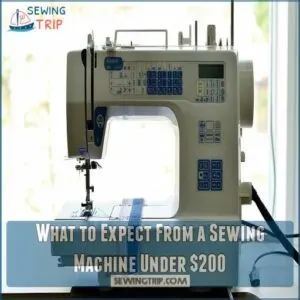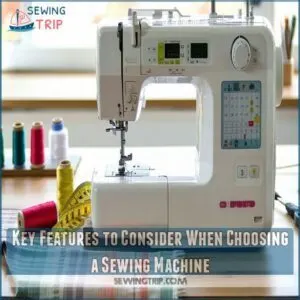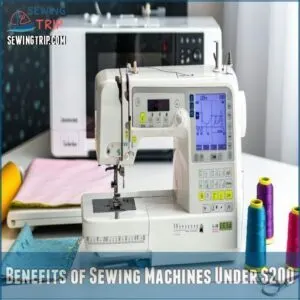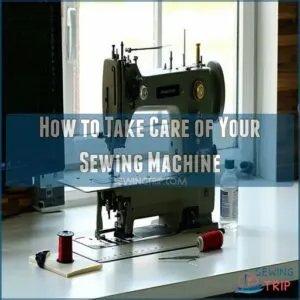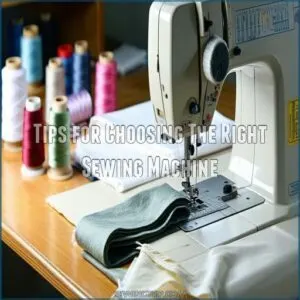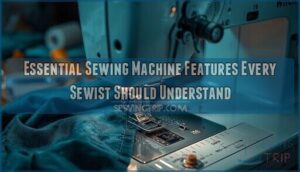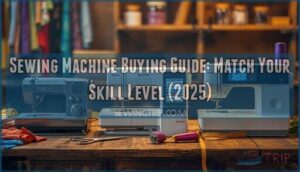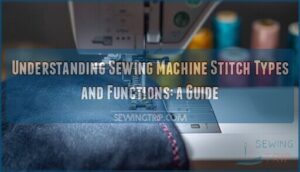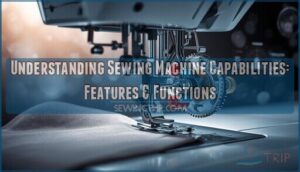This site is supported by our readers. We may earn a commission, at no cost to you, if you purchase through links.
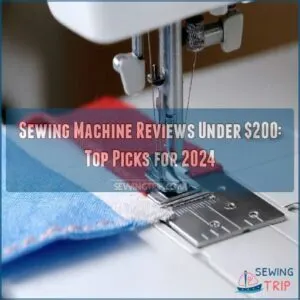
The Brother GX37 offers a mix of 37 built-in stitches and straightforward mechanics, making it perfect for newbies. If you need durability, the Singer Heavy Duty model won’t break the bank—or a sweat—handling tougher fabrics with ease.
Meanwhile, the Brother XM2701 is lightweight and ideal for portability. Each model includes essential features like automatic needle threaders, making sewing less about the hassle and more about creativity.
Ready to discover more hidden treasures? Let’s stitch on!
Table Of Contents
- Key Takeaways
- Top 5 Sewing Machines Under $200
- What to Expect From a Sewing Machine Under $200
- Key Features to Consider When Choosing a Sewing Machine
- Benefits of Sewing Machines Under $200
- How to Take Care of Your Sewing Machine
- Tips for Choosing The Right Sewing Machine
- Frequently Asked Questions (FAQs)
- Conclusion
Key Takeaways
- You’ll find great beginner-friendly machines under $200, like the Brother GX37 and Singer Heavy Duty, balancing affordability and essential features.
- Consider your sewing needs; lightweight models like the Brother XM2701 are perfect for portability, while the Singer Start 1304 offers simplicity for basic projects.
- Automatic features such as needle threaders are common, making sewing easier and more enjoyable, especially for those new to the craft.
- Regular maintenance, such as cleaning and oiling, enhances the longevity and performance of your sewing machine, ensuring long-term satisfaction with your purchase.
Top 5 Sewing Machines Under $200
You’re ready to find the perfect sewing machine without breaking the bank!
Here are five top-rated models under $200,
each offering a great balance of features and affordability for your sewing needs.
1. Brother GX37 Sewing Machine
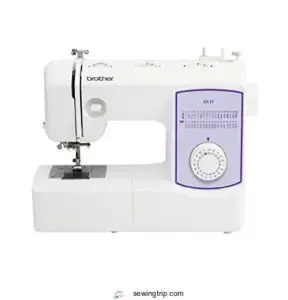
Meet the Brother GX37 Sewing Machine, your budget-friendly companion in the sewing world, perfect for beginners and pros alike.
This machine boasts 37 built-in stitches, including utility and decorative options.
With its automatic needle threader, you’ll save time and avoid fiddly frustrations.
The drop-in top bobbin guarantees smooth, jam-free operation, while the free arm helps tackle sleeves and cuffs effortlessly.
Lightweight and full of features, it offers outstanding value and reliable performance, making everyday sewing projects delightfully simple and stress-free.
Best For: The Brother GX37 Sewing Machine is best for beginner to intermediate sewers looking for a machine with basic features and ease of use.
- Easy to use
- Produces balanced seams
- Automatic needle threader
- Built-in storage compartment is not well-designed
- LED light is dim
- Presser foot lever is awkward to raise
2. Singer Sewing Machine M3330 97 Stitches
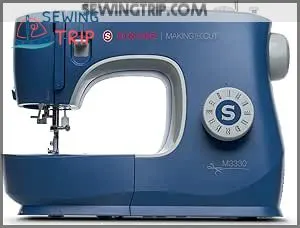
Diving into sewing with the Singer M3330 is like discovering a hidden gem in the fabric world.
This machine offers 97 stitch applications, covering basic, stretch, and decorative stitching needs.
The built-in needle threader saves time, while the one-step buttonhole guarantees consistency every time.
With its lightweight build and metallic blue charm, it’s perfect for both newbies and seasoned sewers.
While setup may require a little patience, you’ll quickly master projects like pants and blouses once you get the hang of it.
Best For: Beginners and experienced sewers looking for a versatile machine with a wide range of stitches.
- 97 stitch applications for basic, stretch, and decorative sewing.
- Built-in needle threader for easier threading.
- Lightweight and easy to operate.
- No manual included, leading to initial setup and bobbin issues for some users.
- Some users found the machine to be slower than older Singer models.
- Thread jamming or tangling issues reported, possibly due to user error.
3. Singer Heavy Duty Sewing Machine
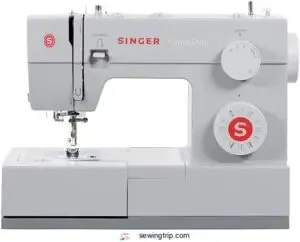
Some might say the Singer Heavy Duty Sewing Machine is the powerhouse in disguise.
It’s ready to tackle your projects, whether you’re crafting costumes for a school play or hemming those stubborn jeans.
This machine’s high-speed capability, combined with a 60% stronger motor, guarantees you sew through thick fabrics like denim without a hiccup.
The built-in needle threader and intuitive design make setup a breeze.
It’s a robust option for those seeking efficiency and durability without breaking the bank.
Best For: This machine is best for beginners and experienced sewers alike who need a reliable and durable machine for everyday projects.
- Handles thick fabrics with ease.
- Quiet and easy to control.
- Comes with a variety of accessories.
- Some users have reported problems with the machine straight out of the box.
- The machine may need some adjustment and troubleshooting to achieve optimal performance.
- While it is a good value, it may not have all the advanced features found in more expensive machines.
4. Singer Start 1304 Sewing Machine
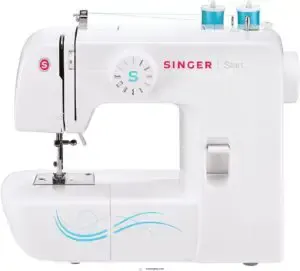
The Singer Start 1304 makes getting into sewing a breeze, acting as a trusty sidekick for beginners.
Weighing just 7 pounds, it’s easy to move around, yet sturdy enough for various projects.
With 57 stitch applications and six stitch types, you’ll have the essentials at your fingertips.
Automatic bobbin winding and double needle support streamline the process, making life simpler.
Its 25-year limited warranty means you can rely on this little machine for the long haul without breaking the bank.
Best For: The Singer Start 1304 is best for beginners and those looking for a simple machine for basic sewing projects.
- Lightweight and portable, making it easy to move around.
- Comes with a 25-year limited warranty for added peace of mind.
- Automatic bobbin winding and double needle support simplify the sewing process.
- The instruction manual is not included in the box, only a picture guide.
- The machine is designed for use in the US and Canada at 110 volts only.
- It may not be suitable for more complex sewing projects.
5. Brother XM2701 Lightweight Sewing Machine
Imagine you’re about to start sewing with the Brother XM2701 Lightweight Sewing Machine.
Packed with 27 built-in stitches, including decorative and zigzag options, it’s got you covered for most projects.
Its automatic needle threader can save you from eye strain, while the drop-in bobbin makes setup a breeze.
Although it might grumble a bit when you tackle heavy fabrics, it’s still a reliable partner for beginners.
Just remember to keep the foot pedal in check!
Best For: The Brother XM2701 is best for beginner sewers and those looking for a lightweight, portable machine for basic sewing projects.
- 27 built-in stitches for a variety of projects
- Automatic needle threader for easy threading
- Drop-in bobbin for convenient setup
- May struggle with heavier materials like denim
- Foot pedal can be sticky and require firm pressure to activate
- LED light is not very bright
What to Expect From a Sewing Machine Under $200
When you’re considering a sewing machine under $200, expect a no-frills model that focuses on the essentials, like basic stitch options and straightforward controls.
It’s perfect for beginners or anyone interested in simple projects, although don’t expect it to handle heavy-duty fabrics without a hiccup or two.
Type of Machine
So, you’ve picked your top contenders—great!
Now, let’s talk about the type of machine. At this price point, you’ll mostly find electric options, maybe a mechanical one. Forget hand-crank machines; those are relics of the past.
Automatic features might be limited but some models offer nifty little automatic needle threaders.
A mini machine could work wonders for small projects. Think about your sewing goals: basic mending? Then a simple beginner sewing machine might be perfect!
Controls and Operation
When eyeing a sewing machine under $200, smooth operation’s key.
Controls should be intuitive. Imagine pressing buttons for the perfect stitch or adjusting a dial for precise thread tensioning.
Foot pedal options offer hands-free control, while automatic needle threading eases setup.
Bobbin winding? A breeze. These user-friendly interfaces make mastering sewing feel like second nature.
Sewing Speed and Performance
Speed is a critical factor when you’re shopping for a sewing machine under $200.
Most models in this range offer ample sewing speed for beginner projects, whether you’re quilting or crafting clothes.
For the best results, consider machines with features like variable speed control, which enables smooth sewing without jamming.
The right machine balances efficiency, making your sewing projects a breeze.
Needles and Thread Options
In a sewing machine under $200, you’ll find a few needle types to choose based on fabric—like denim or cotton—for variety in your projects.
Thread selection is important; opt for high-quality sewing threads to avoid snags.
Consider thread color options that suit your style, ensuring your creations pop. Remember, even on a budget, quality counts.
Number and Type of Stitches
Choosing your stitches is like picking toppings for a pizza; it adds flair to your projects.
With sewing machines under $200, you’ll generally find a blend of straight and decorative stitch options.
Automatic stitch selection simplifies things, balancing ease with variety.
Keep an eye on stitch length and width adjustments to explore limitless creative avenues.
Key Features to Consider When Choosing a Sewing Machine
Before you buy, think about what features matter most to you.
Consider things like the type of stitches offered, the machine’s weight and size.
Consider whether it has helpful extras like an automatic needle threader—because wrestling with a tangled thread is never fun.
Automatic Needle Threader and Buttonholer
When buying a sewing machine under $200, think about how an automatic needle threader and buttonholer can make life simpler.
Machines with these features, such as the Singer Sew Mate 5400 with its 60 built-in stitches, can feel like a dexterous friend offering a spare hand.
Needle threader tips ease your setup, and buttonhole techniques mean you’ll finish projects effortlessly.
With automatic threaders, threading becomes easy, making sewing smoother and more enjoyable.
Variety of Stitches and Sewing Surface
Imagine you’re diving into a sewing project, and your machine’s stitching options become your trusty sidekick.
Under $200, you’ll still find machines offering a variety of stitches, which means:
- Stitch length customization
- Thread tension adjustment
- Fabric compatibility
This variety helps you achieve neat hems, decorative details, and durable seams without breaking the bank, making those sewing dreams a reality!
Presser Feet and Accessories
After you’re familiar with stitch surfaces, it’s time to tackle presser feet and accessories.
Think of presser feet as your trusty sidekicks, each different one ready for specific sewing challenges.
For instance, having a sewing machine zipper foot can make a huge difference in precision and ease when working with zippers.
Sewing machines under 200 bucks often come with a basic set, so you can start right away.
Look for models offering extras—like zipper feet or quilting guides—to stretch your creative wings.
Machine Weight and Portability
A lightweight sewing machine is your ticket to sewing freedom, fitting neatly into your creative lifestyle.
Opt for portable options like a backpack sewing machine, perfect for on-the-go projects.
Compact designs make storage a breeze, while maintaining all the essential features.
Whether you’re tackling travel sewing essentials or setting up at home, these budget-friendly machines under $200 pack power into portability.
Benefits of Sewing Machines Under $200
You might think sewing machines under $200 lack features, but they actually balance affordability and functionality quite well.
These beginner-friendly models are compact and lightweight, making them perfect for those new to sewing or anyone needing a portable option with essential tools.
Beginner-Friendly Machines
So, you’ve got the features nailed down; now, let’s talk ease of use. Beginner-friendly sewing machines under $200 make sewing less intimidating. They’re designed for simple projects.
- Clear instructions.
- Intuitive controls.
- Easy threading.
- Minimal fuss, maximum fun.
- Loads of Easy Sewing Projects!
A beginner sewing machine lets you tackle DIY Home Decor and Simple Stitch Tutorials without feeling overwhelmed. It’s all about finding the perfect fit for your Limited Budget Options.
Balance of Features and Affordability
When you’re working with a sewing machine under $200, you’ve hit the sweet spot between affordability and functionality.
These machines, though budget-friendly, often pack enough punch to handle a variety of tasks.
Sure, you might skip some fancy extras, but for straightforward projects, they bring the right balance of cost-effective sewing and essential features, making them top-rated choices for beginners.
Compact and Portable Designs
Choosing the best sewing machine under $200 means getting compact benefits that fit in small spaces or travel bags.
A portable sewing machine with a travel-sized option gives you freedom to sew anywhere.
With space-saving features, your projects don’t need a dedicated room.
Think foldable frames that tuck away neatly, yet offer DIY capacity anywhere you go.
- Portable case designs
- Mini sewing machines
- Space-saving features
Essential Accessories and Tools
Imagine you’re starting a sewing journey, and a sewing machine under $200 is your trusty sidekick.
Finding sewing kits with varied thread types, sharp sewing scissors, and precise fabric cutters can make all the difference.
Add in ironing tools, and you’ll be ready for anything.
These sewing machine accessories are perfect for beginners or DIY projects, ensuring seamless repairs and creations.
How to Take Care of Your Sewing Machine
To keep your sewing machine humming smoothly, regular cleaning and oiling are as essential as a fresh spool of thread.
Store it properly, troubleshoot common issues when they arise, and you’ll stitch happily ever after without a hitch.
Cleaning and Oiling The Machine
Regular maintenance keeps your sewing machine purring like a kitten. Cleaning and oiling are key; think of it as a spa day for your machine!
Use a soft brush to remove lint and dust.
- Apply a drop of high-quality sewing machine oil to the moving parts.
- Follow your machine’s manual for specific lubrication techniques.
- Consistent cleaning prevents machine breakdown and extends its life.
Storing The Machine and Accessories
When you’ve finished sewing, protect your machine like a treasured heirloom. Use sewing machine covers for dust protection and store in sturdy cases.
Organize your accessories in neat systems to avoid chaos. A budget sewing machine can last longer with good care.
Invest in a machine stand. You’ll keep your sewing machine under $200 pristine and ready for your next project.
Troubleshooting Common Issues
Spotting problems early in sewing machines is essential. Troubleshooting can save you time and frustration.
Here are some common issues:
- Thread Breakage: Check tension settings and use the right needle.
- Needle Damage: Replace dull needles often.
- Bobbin Winding: Make sure of proper bobbin setup and check for tangling.
These tips should keep your sewing experience smooth and stress-free!
Regular Maintenance and Servicing
Nip pesky issues in the bud with regular maintenance.
Start by tuning up machines with a good cleaning. Remove lint and dust from parts, a little oil keeps things running smoothly.
Check threads and needles before each project—avoid tangles!
Storing your machine in a safe place extends its life.
Keep your sewing machine under $200 ready for action anytime!
Upgrading and Accessorizing The Machine
You’ve maintained your machine, now let’s jazz it up with some upgrades.
For the latest products and accessories, check out Sewing Machine Upgrades.
Embrace the joy of enhancing your stitching with these add-ons:
- Foot Pedal Upgrades: Revamp for smoother control.
- Thread Cutter Install: Snip with ease, no scissors required.
- Attachment Kits: Transform simple sewing into versatile creations.
These accessories guarantee every project feels fresh and exciting!
Tips for Choosing The Right Sewing Machine
Choosing the right sewing machine can feel overwhelming, so start by considering what you’ll primarily sew—from simple repairs to elaborate projects.
Then, compare features, read reviews, and check warranties to find the best machine for your needs and budget.
Consider Your Sewing Goals and Needs
Think about what you’ll be sewing:
Are you planning quilting projects or crafting cozy home décor? Maybe you’ll mend clothes or whip up vibrant kids’ outfits.
Matching your machine’s versatility to your skill level can make sewing as smooth as butter.
Explore options that fit well for beginners, crafts, clothes, or even quilting—all under $200!
Research and Read Reviews From Other Users
When diving into budget sewing machine reviews, use user experience to guide you.
Here’s a four-step approach:
- Read User Experiences: Catch authentic stories and insights.
- Analyze Ratings: Spot trends in top rated sewing machines under 200.
- Detect Review Bias: Wonder if it’s all too positive.
- Use Comparison Tools: See what stands out in sewing machine reviews under 200.
Compare Features and Prices
While reading reviews can be enlightening, don’t forget to compare features and prices, considering what best sewing machine under 200 truly offers.
Discover if that budget-friendly option fits your needs by analyzing sewing speed tests and stitch quality.
Check if the user interface is easy to navigate.
By examining these factors, you’ll find the best sewing machine under 200 that combines value and functionality for your projects.
Look for Machines With Essential Accessories
Grabbing the right sewing machine accessories feels like packing for an adventure.
Look for machines that come with a best sewing machine accessories starter kit or sewing machine bag.
Having essential presser feet included is a bonus.
A beginner sewing bundle often means your beginner-friendly sewing machine is ready to tackle creative projects, while the free arm design makes sewing sleeves a breeze.
Consider The Brand and Warranty
Choosing a sewing machine? Brand reputation matters! A solid brand means better quality control and more reliable customer support.
Check the warranty; it’s your safety net.
Consider these factors:
- Manufacturer reliability
- Warranty options
- Brand reputation
- Customer support
A good warranty shows the maker believes in their product. Don’t underestimate the peace of mind a strong warranty provides.
Finding the best sewing machine under $200 is easier with a little research.
Frequently Asked Questions (FAQs)
Which sewing machine should I buy?
With over 80% of beginners opting for machines under $200, consider the Singer MX60 for simplicity and reliability. It’s lightweight with 6 built-in stitches, perfect for new sewers seeking control and practical functionality.
How much does a sewing machine cost?
A sewing machine can cost anywhere from $50 to over $10,000, depending on features, brand, and intended use.
For basic models suitable for beginners, expect to pay around $100 to $200, offering solid functionality without breaking the bank.
What is the cheapest sewing machine?
When you’re on a tight budget, the KPCB Mini Sewing Machine is a budget-friendly choice, offering essential features with simplicity.
It provides decent performance for basic projects without breaking the bank, making it ideal for beginners.
What is the best mechanical sewing machine?
The Singer Making the Cut tops the list for mechanical sewing machines under $
You’re getting 97 stitch applications, a sturdy metal frame, and an easy-to-use needle threader.
Perfect for straightforward sewing tasks at home.
What is the best heavy duty sewing machine?
Want a sewing machine that’ll tackle anything? For heavy-duty sewing, the Brother XM2701 is a top contender. It’s fast, reliable, and built to last. You’ll conquer any project!
What sewing machine is similar to a 2277?
A sewing machine similar to the Singer 2277 is the Brother XM
It offers user-friendly features, 27 built-in stitches, and an automatic needle threader.
Making it perfect for those seeking versatility and simplicity in their sewing projects.
What is the most reliable brand of sewing machine?
You can’t go wrong with Brother or Singer for reliability in sewing machines.
These brands are renowned for their durability and user-friendly designs, making them perfect companions for both beginners and seasoned stitchers alike.
What is the average price of a good sewing machine?
A good sewing machine’s average price ranges from $100 to $400, depending on features, quality, and brand, with mid-range models offering a balance of performance, durability, and affordability for most users.
Is singer or brother better?
Choosing between Singer and Brother hinges on your sewing needs.
Singer offers durability and simplicity, ideal for beginners, while Brother provides versatile features and modern technology.
Both are solid choices, balancing ease and performance effectively.
What is a good first time sewing machine?
Sarah, a beginner, loved her Singer Start 1304’s simplicity.
For your first machine, prioritize ease of use and essential stitches; avoid overly complicated models.
A reliable, basic machine’s perfect for starting your sewing journey.
Are refurbished sewing machines worth considering?
Refurbished sewing machines can offer great value with lower prices and reliable function.
Often, they’re restored by experts and tested for quality.
Just guarantee a good return policy and warranty to guard against potential issues.
What brands offer good customer support?
When you need good customer support, brands like Brother, Singer, and Janome stand out.
They’re known for responsive service, easy-to-understand manuals, and online resources to help you master your sewing machine with confidence and ease.
How long do sewing machines typically last?
Like a sturdy vintage car, a well-maintained sewing machine can last decades.
Typically, they run strong for 5-25 years, depending on use and care.
Regular maintenance boosts longevity, giving you years of crafting freedom.
Is it easy to find replacement parts?
Finding replacement parts for sewing machines is relatively easy.
Most manufacturers, like Singer and Brother, provide accessible options online or through retail outlets.
However, older or rare models might pose a challenge in sourcing specific parts.
What sewing projects suit beginners?
Sewing small tote bags or pillowcases offers beginners a win-win; practice straight lines and creativity.
Simple garments, like aprons, hone key skills.
Jam-packed with useful lessons, these projects boost confidence without overwhelming complexity—just sew and grow!
Conclusion
Finding the perfect sewing machine can feel like searching for a unicorn, but don’t worry!
This guide on sewing machine reviews under $200 has armed you with the knowledge to choose wisely.
Remember to take into account your skill level, sewing needs, and the essential features we discussed.
Whether you’re a beginner or a seasoned pro on a budget, there’s a fantastic machine waiting for you.
Happy sewing! Now go forth and create!
You’ll find the perfect fit among our top 5 picks; explore our detailed sewing machine reviews under $200 to make the best choice for your creative journey.

